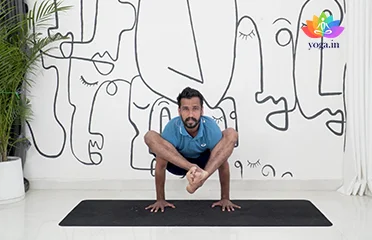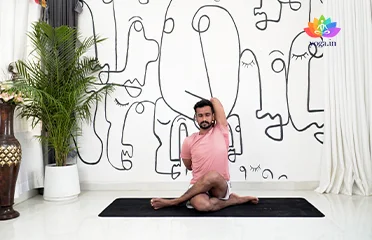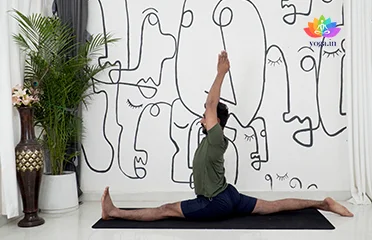Anantasana (Sleeping Vishnu Pose)
अनन्तासन / Sleeping Vishnu Pose | Vishnu's Couch Pose
The Sanskrit name is derived from Ananta (अनन्त) meaning without end [�K]
Anjaneyasana (Crescent Moon Pose)
आंजनेयासन / Crescent Moon Pose
The Sanskrit name is derived from Anjane (आंजने) meaning Hanuman, [�K]
Bhujapidasana (Shoulder-Pressing Pose)
भुजपीडासन / Shoulder-Pressing Pose
The Sanskrit name is derived from Bhuja (भुज) meaning arm/shoulder, Pida [�K]
Gomukhasana (Cow Face Pose)
गोमुखासन / Cow Face Pose
The Sanskrit name is derived from Gau (गो) meaning cow, Mukh meaning face [�K]
Hanumanasana (Monkey Pose)
हनुमानासन / Monkey Pose
The Sanskrit name is derived from the Hindu God -Hanuman (हनुमान) [�K]
How Yoga Can Help Cure Heart Trouble:
Heart trouble refers to various cardiovascular conditions that affect the heart’s ability to function properly. Yoga can help manage and alleviate heart trouble by improving cardiovascular health, reducing stress, and enhancing overall well-being. Through gentle physical postures, breathing exercises, and meditation, yoga can support heart health and promote a sense of calm and balance.
Understanding Heart Trouble:
Heart trouble encompasses a range of cardiovascular conditions, including coronary artery disease, heart attacks, heart failure, arrhythmias, and hypertension. These conditions can lead to serious health complications and impact daily life. Understanding the different types of heart trouble and their symptoms is crucial for effective management and treatment.
Yoga’s Role in Relieving Heart Trouble:
Specific yoga practices can help alleviate the symptoms of heart trouble by improving blood circulation, reducing stress, and promoting relaxation. Gentle yoga postures can enhance cardiovascular function, while pranayama (breathing exercises) can help regulate the heart rate and reduce anxiety. Meditation techniques can further support mental and emotional well-being.
Key Factors Contributing to Heart Trouble:
Several factors can contribute to the development of heart trouble, including:
- High Blood Pressure: Persistent high blood pressure can damage the heart and arteries.
- High Cholesterol: Excess cholesterol can lead to the buildup of plaques in the arteries.
- Smoking: Smoking damages blood vessels and increases the risk of heart disease.
- Obesity: Excess body weight puts additional strain on the heart.
- Diabetes: High blood sugar levels can damage blood vessels and the heart.
- Sedentary Lifestyle: Lack of physical activity can contribute to cardiovascular issues.
- Stress: Chronic stress can negatively impact heart health.
Symptoms of Heart Trouble:
Common symptoms of heart trouble include:
- Chest Pain: A sensation of discomfort or pain in the chest.
- Shortness of Breath: Difficulty breathing, especially during physical activity.
- Fatigue: Feeling unusually tired and lacking energy.
- Palpitations: Irregular or rapid heartbeat.
- Swelling: Swelling in the legs, ankles, or abdomen.
- Dizziness: Feeling lightheaded or dizzy.
- Nausea: A feeling of sickness, often accompanied by chest pain.
Treatment of Heart Trouble through Yoga and Pranayama:
Yoga and pranayama can be very beneficial in managing heart trouble. Some effective practices include:
Specific Yoga Poses:
- Tadasana (Mountain Pose): Improves posture and enhances circulation.
- Vrikshasana (Tree Pose): Enhances balance and strengthens the heart.
- Bhujangasana (Cobra Pose): Opens the chest and improves blood flow.
Pranayama Exercises:
- Anulom Vilom (Alternate Nostril Breathing): Balances the mind and reduces stress.
- Bhramari (Bee Breath): Calms the mind and reduces stress levels.
Diet for Heart Trouble:
A heart-healthy diet can complement yoga treatment for heart trouble. Recommendations include:
- Fruits and Vegetables: Rich in vitamins, minerals, and antioxidants.
- Whole Grains: Provide fiber and help maintain healthy blood pressure.
- Lean Proteins: Sources like fish, chicken, and legumes support heart health.
- Healthy Fats: Found in nuts, seeds, and olive oil.
- Low Sodium: Reducing salt intake can help manage blood pressure.
Caution for Heart Trouble:
While practicing yoga for heart trouble, it is essential to:
- Avoid Overexertion: Practice at a gentle pace and avoid strenuous poses.
- Monitor Heart Rate: Be aware of your heart rate and avoid rapid changes in posture.
Always consult with a healthcare provider before starting any new exercise regimen, especially if you have heart trouble.
Contraindications for Heart Trouble:
Individuals with severe heart trouble or those experiencing significant symptoms should:
- Avoid High-Intensity Yoga: Vigorous practices might exacerbate symptoms.
- Steer Clear of Certain Poses: Inversions and poses that compress the chest may increase discomfort.
- Seek Professional Guidance: Consult a yoga therapist or healthcare professional for personalized recommendations.






